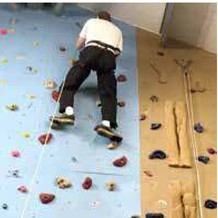The Moderator of the General Assembly of the Church of Scotland, the Rt Rev Dr Russell Barr, highlights why there are lessons to learn from the innovative farming communities of Perthshire.

Climbing wall at Compass Christian Centre, Glenshee
INNOVATION, diversification and putting the latest computer technology to good use: these are some of the things this ‘townie’ Moderator learned from our recent visit to the rural Presbytery of Dunkeld and Meigle.
Although I had the good sense to marry a farmer’s daughter, having lived in towns and cities all my life, my knowledge of agriculture and the rural way of life is limited to occasionally watching television programmes like Countryfile.
So along with visits to congregations, schools and various other places of interest throughout the Presbytery, including the Compass Christian Centre at Glenshee where they had me climbing a wall, I was delighted the Presbytery programme included visits to a number of farms and estates.
As well as hill farms where sheep and cattle are the only viable option, Perthshire boasts some of the best soft fruit, potato and vegetable farmlands in the country, crops which are grown alongside the more traditional crops of barley and wheat.
As we met farmers, it was fascinating to learn how they are diversifying into different types of vegetables, including organically grown.
It was also interesting to see how fruit farmers are making good use of technology to regulate temperature and water supply to their crops.
With Coupar Angus boasting a large chicken processing factory, we also had the opportunity to visit one of the farms where tens of thousands of chickens are reared, the temperature, humidity and feeding of the birds carefully monitored by using the latest computer technology and adjusted through an app on the farmer’s phone.
We also had the opportunity to see how small scale hydro-electric schemes are transforming the economic viability of one estate.
Another estate had built a number of workshops and, as well as generating employment and income for the local economy, the workshops were also generating a valuable income for the estate.
Of course, with the tourist and agricultural industries in Pitlochry, Aberfeldy, Dunkeld, Blairgowrie, Kenmore and their surrounding areas so dependent on foreign labour, there is considerable concern about the implication of Brexit.
And with 85% of the farms, especially the hill farms, receiving some sort of financial support, the future is full of uncertainty.
However given the evident willingness of the farmers we met to embrace change, innovate, diversify, make good use of technology, and to think and act strategically, I was left in no doubt that whatever challenges the future holds they are well placed to meet them.
Could the same be said of the church? As we have travelled around the country, from the rural congregations of Dunkeld and Meigle to the congregations in our towns and cities, Margaret and I have been impressed at the ways in which many congregations are seeking to innovate and diversify, making good use of Messy Church, holding simple mid-week ervices, web-steaming services, renovating and refurbishing their buildings into flexible multi-purpose spaces, and engaging with the people of their local communities.
However we have also encountered resistance and an unwillingness to recognise the patterns of worship and church life which served a previous generation well, are no longer serving the spiritual needs of the present generation as well.
Of course, the God we worship is the same yesterday, today and tomorrow, and the last thing I am advocating is that we simply forget or ignore our traditions and history of worship, pastoral care, Christian witness and service.
However as the farming community is demonstrating, a changed and changing environment demands something different and, from the Christian perspective, our confidence for the future lies in the God who promises to make all things new.